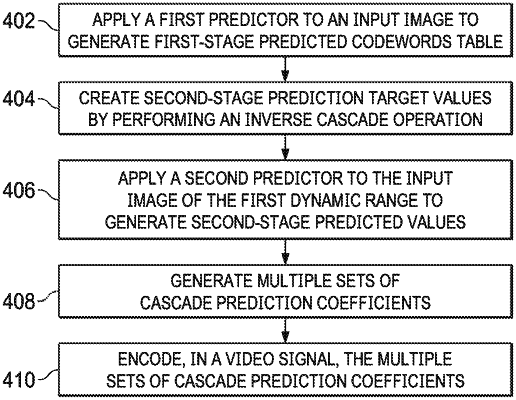| CPC H04N 19/50 (2014.11) [H04N 19/186 (2014.11); H04N 19/1887 (2014.11)] | 13 Claims |

|
1. A method comprising:
applying a first predictor to an input image coded in a first dynamic range domain to generate first-stage predicted codewords approximating prediction target codewords of a prediction target image coded in a second dynamic range domain that is different from the first dynamic range domain;
creating second-stage prediction target values by performing an inverse cascade operation on the prediction target codewords and the first-stage predicted codewords;
applying a second predictor to the input image in the first dynamic range domain to generate second-stage predicted values approximating the second-stage prediction target values;
generating multiple sets of cascade prediction coefficients based on the first-stage predicted codewords and the second-stage predicted values, wherein the multiple sets of cascade prediction coefficients comprise a first set of cascade prediction coefficients specifying the first predictor, wherein the multiple sets of cascade prediction coefficients comprise a second different set of cascade prediction coefficients specifying the second predictor; and
encoding, in a video signal, the multiple sets of cascade prediction coefficients as image metadata, wherein the video signal is further encoded to include the input image coded in the first dynamic range domain, wherein a recipient device of the video signal is caused to use the multiple sets of cascade prediction coefficients to apply the first predictor and the second predictor to the input image to generate a predicted image in the second dynamic range domain, wherein the predicted image in the second dynamic range domain approximates the prediction target image in the second dynamic range domain,
wherein the first predictor comprises a first luma predictor and a first chroma predictor, wherein the second predictor comprises a second luma predictor and a second chroma predictor, wherein the first and second luma predictors are different types of luma predictors, wherein the first and second chroma predictors are different types of chroma predictors, and wherein the first luma predictor represents a single-channel polynomial predictor, and wherein the second luma predictor represents a multi-channel multivariate multiple regression (MMR) predictor.
|